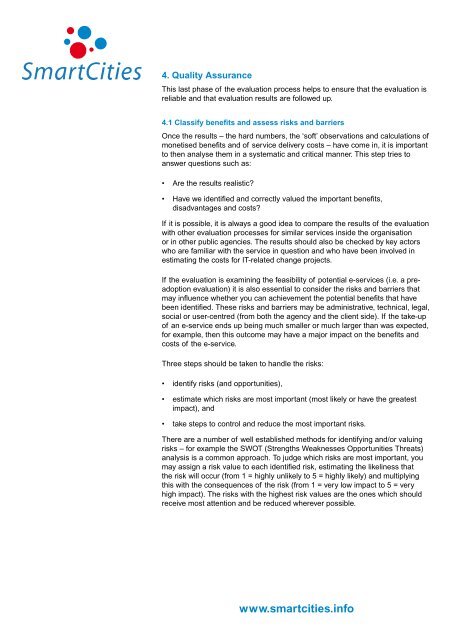Evaluating the impact of local e-services - Smart Cities
Evaluating the impact of local e-services - Smart Cities
Evaluating the impact of local e-services - Smart Cities
You also want an ePaper? Increase the reach of your titles
YUMPU automatically turns print PDFs into web optimized ePapers that Google loves.
4. Quality Assurance<br />
This last phase <strong>of</strong> <strong>the</strong> evaluation process helps to ensure that <strong>the</strong> evaluation is<br />
reliable and that evaluation results are followed up.<br />
4.1 Classify benefits and assess risks and barriers<br />
Once <strong>the</strong> results – <strong>the</strong> hard numbers, <strong>the</strong> ‘s<strong>of</strong>t’ observations and calculations <strong>of</strong><br />
monetised benefits and <strong>of</strong> service delivery costs – have come in, it is important<br />
to <strong>the</strong>n analyse <strong>the</strong>m in a systematic and critical manner. This step tries to<br />
answer questions such as:<br />
• Are <strong>the</strong> results realistic?<br />
• Have we identified and correctly valued <strong>the</strong> important benefits,<br />
disadvantages and costs?<br />
If it is possible, it is always a good idea to compare <strong>the</strong> results <strong>of</strong> <strong>the</strong> evaluation<br />
with o<strong>the</strong>r evaluation processes for similar <strong>services</strong> inside <strong>the</strong> organisation<br />
or in o<strong>the</strong>r public agencies. The results should also be checked by key actors<br />
who are familiar with <strong>the</strong> service in question and who have been involved in<br />
estimating <strong>the</strong> costs for IT-related change projects.<br />
If <strong>the</strong> evaluation is examining <strong>the</strong> feasibility <strong>of</strong> potential e-<strong>services</strong> (i.e. a preadoption<br />
evaluation) it is also essential to consider <strong>the</strong> risks and barriers that<br />
may influence whe<strong>the</strong>r you can achievement <strong>the</strong> potential benefits that have<br />
been identified. These risks and barriers may be administrative, technical, legal,<br />
social or user-centred (from both <strong>the</strong> agency and <strong>the</strong> client side). If <strong>the</strong> take-up<br />
<strong>of</strong> an e-service ends up being much smaller or much larger than was expected,<br />
for example, <strong>the</strong>n this outcome may have a major <strong>impact</strong> on <strong>the</strong> benefits and<br />
costs <strong>of</strong> <strong>the</strong> e-service.<br />
Three steps should be taken to handle <strong>the</strong> risks:<br />
• identify risks (and opportunities),<br />
• estimate which risks are most important (most likely or have <strong>the</strong> greatest<br />
<strong>impact</strong>), and<br />
• take steps to control and reduce <strong>the</strong> most important risks.<br />
There are a number <strong>of</strong> well established methods for identifying and/or valuing<br />
risks – for example <strong>the</strong> SWOT (Strengths Weaknesses Opportunities Threats)<br />
analysis is a common approach. To judge which risks are most important, you<br />
may assign a risk value to each identified risk, estimating <strong>the</strong> likeliness that<br />
<strong>the</strong> risk will occur (from 1 = highly unlikely to 5 = highly likely) and multiplying<br />
this with <strong>the</strong> consequences <strong>of</strong> <strong>the</strong> risk (from 1 = very low <strong>impact</strong> to 5 = very<br />
high <strong>impact</strong>). The risks with <strong>the</strong> highest risk values are <strong>the</strong> ones which should<br />
receive most attention and be reduced wherever possible.<br />
www.smartcities.info



